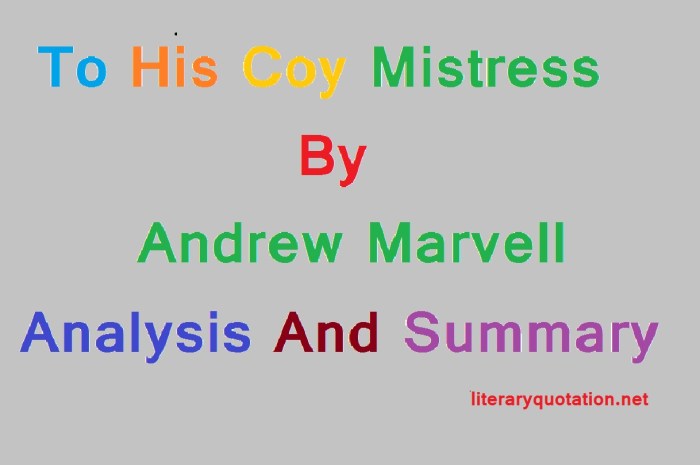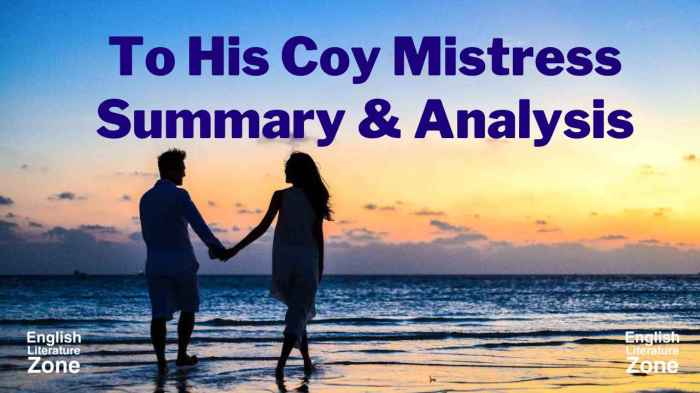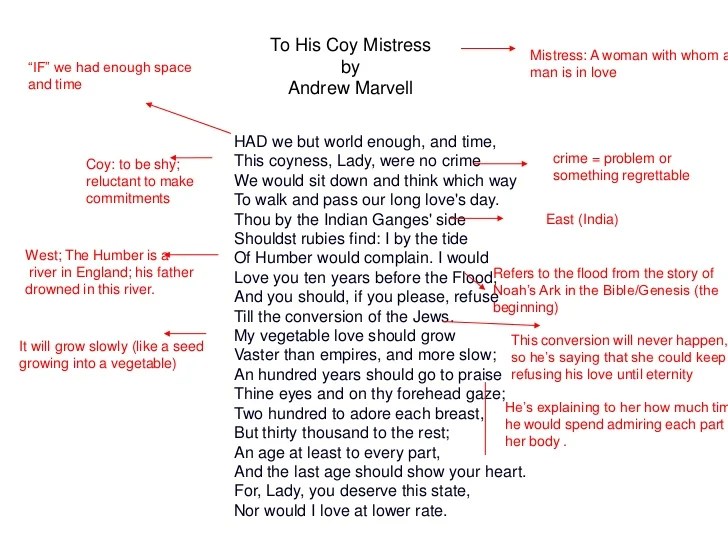Coy mistress annie finch analysis – Annie Finch’s “Coy Mistress” is a captivating exploration of love, time, and mortality, inviting readers to delve into the complexities of human desire and the fleeting nature of existence.
Finch’s poem masterfully employs imagery, symbolism, and poetic techniques to convey a profound and nuanced understanding of these timeless themes.
1. Historical Context
Andrew Marvell’s “The Coy Mistress” emerged during the 17th-century literary period known as the Metaphysical Movement. This movement emphasized wit, intellectualism, and the exploration of complex emotions. The poem’s setting in a secluded garden during the Renaissance era influences the speaker’s perspective, as it reflects the social and cultural norms of the time, where courtship and romantic relationships were often subject to societal constraints.
2. Poetic Structure and Form
The poem follows an ABABCC rhyme scheme and employs iambic tetrameter, with four stressed syllables in each line. This structured form creates a sense of rhythm and flow, enhancing the poem’s musicality and impact.
3. Speaker’s Perspective and Tone

The speaker’s perspective is that of a passionate and persuasive lover, who attempts to convince his coy mistress to seize the moment and engage in a physical relationship with him. His tone is urgent and seductive, reflecting his desire to overcome the social and moral constraints that prevent them from indulging in their passion.
4. Imagery and Symbolism

The poem employs vivid imagery, such as “the grave’s a fine and private place” and “Time’s winged chariot hurrying near,” to convey the fleeting nature of life and the urgency of the speaker’s plea. The use of metaphors and personification, such as “Time’s winged chariot” and “our hands’ interlock’d,” enhances the poem’s emotional impact and adds depth to its themes.
5. Themes and Interpretations
The poem explores central themes of love, time, and mortality. The speaker argues that the brevity of life demands that they seize the present moment and indulge in their physical desires. Different interpretations of the poem’s meaning range from a celebration of physical love to a critique of societal constraints on passion.
6. Literary Devices and Techniques: Coy Mistress Annie Finch Analysis
Marvell employs literary devices such as metaphor (“Time’s winged chariot”), simile (“as the world’s a rose”), and personification (“Time’s winged chariot hurrying near”) to create vivid imagery and convey the urgency of his plea. These techniques enhance the poem’s emotional impact and add depth to its themes.
7. Comparison to Other Works

The poem shares similarities with other works of the Metaphysical Movement, such as John Donne’s “The Sun Rising” and “A Valediction: Forbidding Mourning,” in its exploration of complex emotions, use of wit, and intellectualism. However, Marvell’s poem stands out for its unique perspective on love and its persuasive tone.
8. Critical Reception and Legacy
Upon its publication, “The Coy Mistress” received critical acclaim for its wit, passion, and exploration of complex themes. Over time, it has become one of the most celebrated and analyzed poems in English literature, influencing countless other poets and inspiring adaptations in various art forms.
Common Queries
What is the central theme of “Coy Mistress”?
The central theme is the tension between the speaker’s desire for immediate gratification and the inevitability of time’s passage.
How does Finch use imagery to convey the fleeting nature of time?
Finch uses imagery of flowers, seasons, and the sun to symbolize the transience of life and the urgency of seizing the present moment.
What is the significance of the speaker’s tone in the poem?
The speaker’s tone is both passionate and pleading, reflecting the urgency of their desire and the bittersweet realization of time’s relentless march.